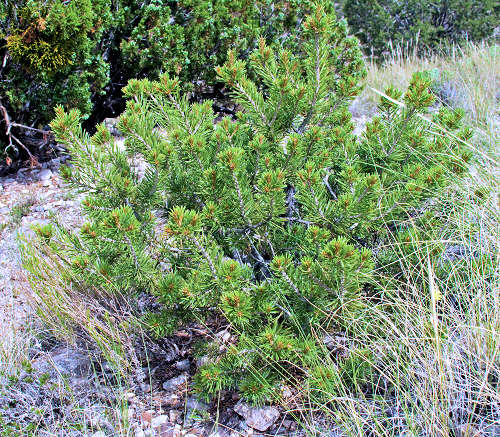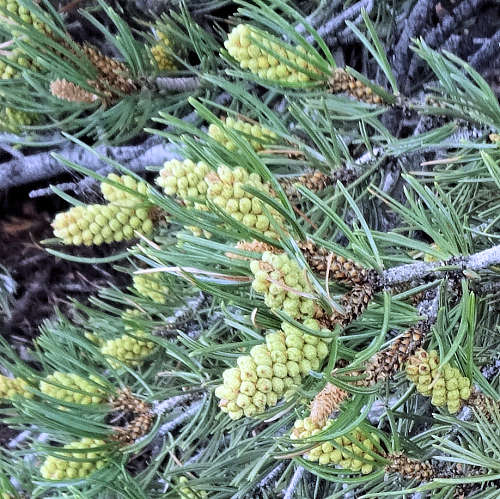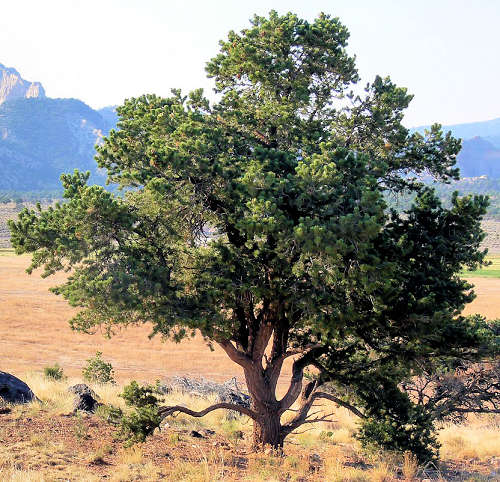Botanical Overview
A member of the Pine family (Pinaceae), the Pinus genus contains 130 species of evergreen
conifers found throughout the world. Most occur in Northern temperate regions.
The Pinyon Group refers to species of pine trees native to North America that produce
edible, large, wingless seeds called pine nuts. Of these, Pinus edulis is the most abundant,
well documented, and most available at nurseries.
Pinus edulis is slow growing, thrives in the wild at altitudes of 4000–8,800'
(1220-2680km), and is drought tolerant.
It is best used as a small, ornamental shrub that will produce tasty nuts 25 years later.
This species, and a second, Pinus monophylla: Singleleaf Pinyon, are commercially harvested
yearly, in the wild, for their nuts.
Description
Form:
A tree with a conical or rounded shape.
Lifespan:
500-1000 years.
Leaf retention:
Evergreen.
Growth rate:
Slow, at 2" (5cm) per year, until it has attained a 30-36" (75-90cm) height, when it may
grow 4-6" (10-15cm) per year with proper care.
| Pinyon Pine under Cultivation |
Age in Years | Growth Rate / Year |
Height & Width |
| 9 | 2" (5cm) | 1.5' (45cm) |
| 18 | 2" (5cm) | 3' (90cm) |
| 30 | 6" (15cm) | 9' (2.75m) |
Mature Size:
10-56' (3-17m) high and as wide, depending on location and climate.
Breeding System:
Pinyon pines (and all pines) have single-sex cones, with both sexes on the same tree.
The female cone is a woody structure, 1.5-2.0" (3.8-5cm) long, composed of multiple
flattened twigs called scales, each bearing two ovules ready to receive wind-borne pollen
and become seeds.
The scales are tightly closed during seed development.
The upper half of the tree contains mostly female cones, with smaller, clustered, non-woody,
pollen-bearing male cones, 1/4" (6mm) in diameter, on lower branches.
Bisexual cones occur in some individual trees.
Pollen Dispersal:
Cones open to disperse and receive pollen mid to late spring, then close. These trees
alternate between large and insignificant crops, with large crops happening every 3-7 years
in the wild. Lack of water and nutrients are the cause of this fluctuation, with abundant
water observed to improve crop frequency.
Self-fruitful:
Yes. Cross-bred cones produce more seeds, and seeds with a higher germination rate, so a
second tree is desirable. This tree easily hybridizes with another pine species, Pinus
monophylla: Singleleaf Pinyon.
Years before fruiting:
25. Significant crop production occurs at 75-100 years, with maximum production at 160-200
years.
Seed:
Wingless pine seeds are encased in a woody pine cone. Each cone, if pollinated, holds 10-20
thin-shelled seeds, called pine nuts.
Months for fruit to ripen:
The pine cones take 2-3 years to mature. Remove the entire cone from the tree when it starts
to open to keep seeds from falling to the ground. Use gloves to avoid becoming sticky with
resin. Dark colored seeds have nuts inside. Light colored seeds tend to be void of nuts.
Use a rolling pin to gently crack open the shell without damaging the kernel.
Storage after harvest:
Pine nuts can be refrigerated, in a sealed plastic bag, up to one month or frozen up to three
months. They can be eaten raw but are often roasted.
Leaves:
Green needles, up to 2" (5cm) long, in pairs. Leaves stay on the tree for up to 9 years.
Stems:
The trunk is usually short and crooked in the wild.
The bark is smooth on young plants but becomes rough and furrowed with age.
The tree is resinous and will drip sap on anything below.
Roots:
A taproot can extend at least 20' (6m) deep.
Lateral roots are shallow, usually 6-16" (15-40cm) deep, and extend to twice the crown radius or more.
The roots are allelopathic, preventing many plant species from growing near the crown
due to an accumulation of mineral salts.
Wildlife:
The pine cone seeds attract birds and small mammals.
Toxic / Danger:
Not to humans or pets. Eating needles may cause abortion in cows.
Origin:
Primarily Arizona, Colorado, New Mexico and Utah. Small populations are found
in adjacent states and Mexico. Pinyon Pine is the state tree of New Mexico.
Cultivation and Uses
USDA hardiness zones:
5-8.
Chill hours:
Unknown.
Heat tolerant:
Yes, except afternoon shade is needed in USDA zone 9.
Drought tolerant:
Yes.
Sun:
Seedlings need all day part shade in the first year. In following years the plant needs
increasingly more sun, yet with afternoon part shade, then becomes shade intolerant in
its native habitat. In USDA zone 9, plants will need permanent afternoon shade, which may be
deciduous.
Planting:
This plant prefers locations over 4000' (1220m) in elevation.
Place it in natural, unamended soil 3-20' (1-6m) deep.
If it is purchased as a shrub 18" (45cm) high or more in a pot, it should have part
shade, especially afternoon shade, for its first year. After that, it may have full sun.
If it is planted as a seed or one-year old seedling, it should have all day part shade
in the first year, then afternoon part shade for the next four years.
It should be protected from predators by a fence or cage for the first 3-5 years.
In zone 9, the plant must have permanent afternoon part shade from a taller shrub or tree.
Pinus edulis grows underground roots faster and longer than its above ground structure and
does not transplant well out of the ground.
Soil:
Well draining, dry, low in organic content, pH 6.5 to 8.4 (neutral to alkaline).
Fertilize:
Apply composted manure once in late winter.
Water after becoming established:
Deep water every two weeks in warm weather, once a month in winter. Insufficient water is
signaled by unusual leaf drop.
Mulch:
Unnecessary.
First Three Years Care:
Water weekly, but do not overwater. The soil must be dry before watering again. Provide all day
part shade the first year, then afternoon part shade. Do not fertilize the first year. Use a
cage to protect from rodents and browsing critters.
Prune:
Keep all plants and grasses at least 3' (1m) away from seedlings.
This plant is not usually pruned due to its slow growth rate.
Litter:
Low.
Propagation:
Seed are viable for no more than one year. Germination occurs most readily just below the
surface of moist soil, with temperatures between 65-75°F (18-24°C), and with 15
hours of indirect light. Direct sunlight must be avoided.
Cold stratification, or planting in the fall, speeds germination time but does not affect
percentage.
Washing the seed in running tap water for 48 hours (leaching) seems to improve germination
percentage.
Vegetative propagation has not been observed in this species.
Uses:
Ornamental for the first 25 years, followed by gradually increasing seed crop production.
Crushed pinecones are made into incense.
Comments
Additional common names for this tree are Two Needle Pinyon, Piñon Pine, Colorado
Pinyon, and Pinyon Nut Pine.
Other Pinyon Pines with significant wild nut harvests in North America are Pinus monophylla:
Singleleaf Pinyon, and Pinus cembroides: Mexican Pinyon, harvested in Mexico.
Do you have additional information or a different experience for these plants that you would
like to share? Email info@GardenOracle.com. All contributions are welcome and appreciated.






